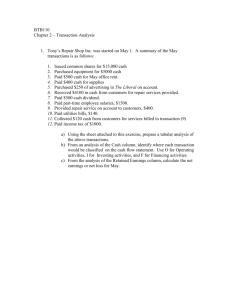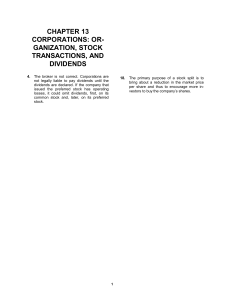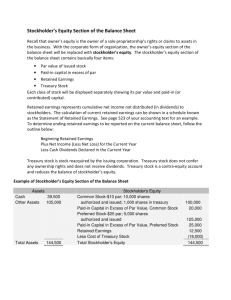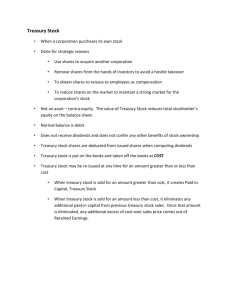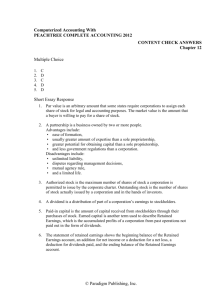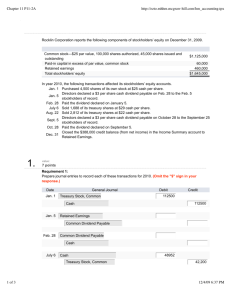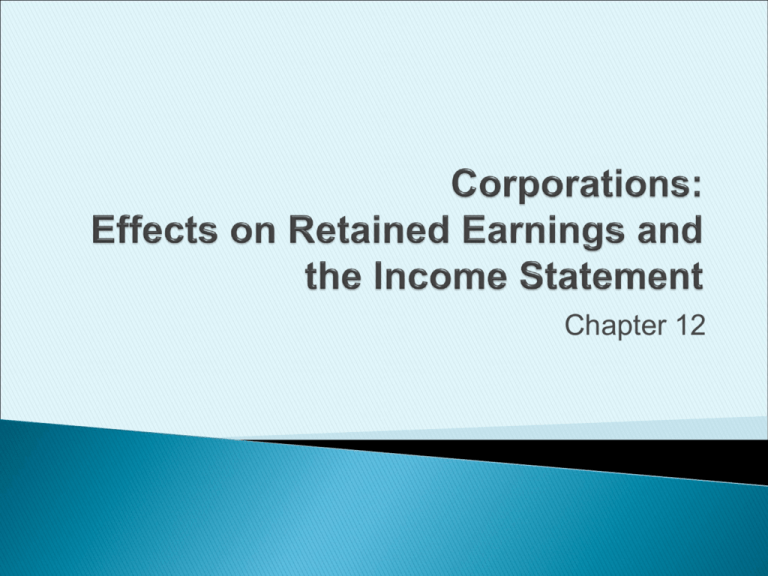
Chapter 12
Account for stock dividends
Proportional distribution of corporation’s own stock
to shareholders
◦ No cash provided to shareholders
Does not change total stockholders’ equity
◦ Transfer of retained earnings to contributed capital
Common
stock
Retained
earnings
Copyright (c) 2009 Prentice Hall. All rights reserved.
3
Conserve
cash
Reduce
market price
Reward
investors
• Continue
dividends
without using
cash
• Increased
supply of
shares may
cause price to
fall
• Shareholders
feel they have
received
something of
value
Copyright (c) 2009 Prentice Hall. All rights reserved.
4
Small
Distribution is less
than 20 to 25% of
issued shares
Debit Retained
earnings for market
value of shares to be
distributed
Large
Distribution is greater
than or equal to 25%
of issued shares
Debit Retained
earnings for par or
stated value of
shares
Rare
Copyright (c) 2009 Prentice Hall. All rights reserved.
5
10% x 450 = 45 share dividend
GENERAL JOURNAL
DATE
Apr
30
DESCRIPTION
REF
Retained earnings (45 x $17)
DEBIT
CREDIT
765
Common stock (45 x $1)
45
Paid-in capital in excess of par-C/S
Copyright (c) 2009 Prentice Hall. All rights reserved.
720
6
Seabury Occupational Therapy, Inc.
Stockholders' Equity
April 30, 2010
Paid-in capital:
Common stock, $1 par, 1,000 shares
495
$
authorized, 495 issued
2,520
Paid-in capital in excess of par
3,015
Total paid-in capital
127,235
Retained earnings
$ 130,250
Total stockholders' equity
Copyright (c) 2009 Prentice Hall. All rights reserved.
7
Account for stock splits
Increases:
◦ the number of shares authorized, issued and
outstanding
Decreases:
◦ par value per share
◦ market value
Balances in the accounts are unchanged
Record in a memorandum entry
Copyright (c) 2009 Prentice Hall. All rights reserved.
9
A company has 25,000 shares of $10 par
common stock outstanding
A 2-for-1 stock split is declared
Results in 50,000 shares of $5 par common
stock outstanding
Copyright (c) 2009 Prentice Hall. All rights reserved.
10
Event
Common
stock
Paid-in capital in
excess of par
Retained
earnings
Total
stockholders’
equity
Cash
dividend
No effect
No effect
Decrease
Decrease
Stock
dividend
Increase
Increase
Decrease
No effect
Stock
split
No effect
No effect
No effect
No effect
Copyright (c) 2009 Prentice Hall. All rights reserved.
11
Account for treasury stock
Shares that a company has issued and later
reacquired
Reasons corporations purchase their own stock:
◦
◦
◦
◦
To increase net assets by buying low and selling high
To support the company’s stock price
To avoid a takeover by an outside party
To reward valued employees with stock
Copyright (c) 2009 Prentice Hall. All rights reserved.
13
Contra-equity account
◦ Debit balance
Recorded at cost (not par)
Reported beneath Retained earnings on the
balance sheet
◦ Reduction to total stockholders’ equity
Decreases outstanding shares
◦ Not eligible for dividends
Outstanding
shares
Issued
shares
Treasury
shares
Copyright (c) 2009 Prentice Hall. All rights reserved.
14
GENERAL JOURNAL
DATE
DESCRIPTION
REF
DEBIT
CREDIT
Treasury stock
Cash
To record purchase of treasury shares
Copyright (c) 2009 Prentice Hall. All rights reserved.
15
If treasury stock is sold above cost, the excess is credited
to “Paid-in capital from treasury stock transactions”
GENERAL JOURNAL
DATE
DESCRIPTION
REF
DEBIT
CREDIT
Cash
Treasury stock (at cost)
Paid-in capital from treasury
stock transactions
Copyright (c) 2009 Prentice Hall. All rights reserved.
16
If treasury stock is sold below cost, the shortfall is debited
to “Paid-in capital from treasury stock transactions”
IF there is a
sufficient balance
Otherwise, Retained earnings is
debited for any remaining shortfall
Copyright (c) 2009 Prentice Hall. All rights reserved.
17
Situation 1 – Paid-in capital from treasury stock
has a sufficient balance to cover the shortfall
GENERAL JOURNAL
DATE
DESCRIPTION
REF
DEBIT
CREDIT
Cash
Paid-in capital from treasury
stock transactions
Treasury stock (at cost)
Copyright (c) 2009 Prentice Hall. All rights reserved.
18
Situation 2 – Paid-in capital from treasury stock
has a balance too small to cover shortfall
GENERAL JOURNAL
DATE
DESCRIPTION
REF
DEBIT
CREDIT
Cash
Paid-in capital from treasury
stock transactions
For amount that
zeros out account
Retained earnings
Treasury stock (at cost)
Copyright (c) 2009 Prentice Hall. All rights reserved.
19
Situation 3 – Paid-in capital from treasury stock
has a zero balance
GENERAL JOURNAL
DATE
DESCRIPTION
REF
DEBIT
CREDIT
Cash
Retained earnings
Treasury stock (at cost)
Copyright (c) 2009 Prentice Hall. All rights reserved.
20
Report restrictions on retained earnings
Restrictions
Requirement by
lenders to maintain a
minimum level of
equity by limiting:
◦ payment of dividends
◦ purchases of treasury
stock
Reported in the notes
to the financial
statements
Appropriations
Restrictions on
retained earnings
recorded by formal
journal entries
Board of Directors
may designate
purpose of
appropriation
Copyright (c) 2009 Prentice Hall. All rights reserved.
22
Complete a corporate income statement including
earnings per share
Any Corporation
Income Statement
Sales revenue
Cost of goods sold
Gross profit
Operating expenses
Operating income
Other gains (losses)
Income from continuing operations before income tax
Income tax expense
Income from continuing operations
Discontinued operations, net of tax
Income before extraordinary items
Extraordinary loss, net of tax
Net Income
Copyright (c) 2009 Prentice Hall. All rights reserved.
24
Measures profitability of the ongoing operations
Useful for making projections about future earnings
Any Corporation
Income Statement
Sales revenue
Cost of goods sold
Gross profit
Operating expenses
Operating income
Other gains (losses)
Income from continuing operations before income tax
Income tax expense
Income from continuing operations
Copyright (c) 2009 Prentice Hall. All rights reserved.
25
Reported after income from continuing operations
Discontinued
operations
Extraordinary
items
Copyright (c) 2009 Prentice Hall. All rights reserved.
26
Segment of a business that has been sold
◦ Identifiable division of company
Reported separately because they will not be
around in the future
Shown net of tax
◦ Gain - income tax expense = Gain, net of tax
◦ Loss - income tax savings = Loss, net of tax
Copyright (c) 2009 Prentice Hall. All rights reserved.
27
Both unusual and infrequent
Examples:
◦ Losses from natural disasters
◦ Foreign government takeover (expropriation)
Reported net of income tax effect
Copyright (c) 2009 Prentice Hall. All rights reserved.
28
Most widely used business statistic
Measures amount of net income for each share of
common stock outstanding
◦ Issued shares – treasury shares = outstanding shares
Key measure of success in business
Copyright (c) 2009 Prentice Hall. All rights reserved.
29
Earnings per share
Net income – preferred dividends
Average number of common shares
outstanding
EPS figures are reported for:
Income from continuing operations
Income from discontinued operations
Income before extraordinary items
Extraordinary gains or losses
Net Income (Loss)
Copyright (c) 2009 Prentice Hall. All rights reserved.
30
Net income – preferred dividends
1,000 shares x $30 par x 2%
$110,000
$600
$109,400
Numerator
of EPS
Copyright (c) 2009 Prentice Hall. All rights reserved.
31
Average number of common shares outstanding
52,000 shares issued
2,000 treasury shares
50,000 common shares outstanding
Copyright (c) 2009 Prentice Hall. All rights reserved.
32
Net income – preferred dividends
Average number of common shares
outstanding
$109,400
50,000
$2.19 EPS
Copyright (c) 2009 Prentice Hall. All rights reserved.
33
Reports how retained earnings changed over the
accounting period
Any Corporation
Statement of Retained Earnings
For the year ended December 31, 2011
Retained earnings, December 31, 2010
$$$$
Plus: Net income
$$$$
$$$$
Less: Dividends
($$$)
Retained earnings, December 31, 2011
$$$$
Copyright (c) 2009 Prentice Hall. All rights reserved.
34
Corrections to Retained earnings for errors of an
earlier period
Correcting entry includes
◦ Debit or credit to Retained Earnings for error amount
◦ Debit or credit to asset or liability account that was
misstated
Reported on Statement of Retained Earnings
Copyright (c) 2009 Prentice Hall. All rights reserved.
35
Change in total stockholders’ equity from all
sources other than from its owners
Net income plus or minus
◦ Unrealized gains/losses on certain investments
◦ Foreign currency translation adjustments
Copyright (c) 2009 Prentice Hall. All rights reserved.
36


